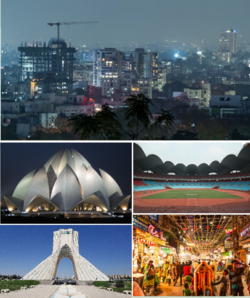Enquilapur: Difference between revisions
(Created page with "{{Infobox settlement |name = Enquilapur<br/> ''एन्क़िलपुर'' |official_name = ''Enquilapur By Rettferdig Nasjonal Sosialistike Stat''<br> ''एन्क़िलपुर आर्ति राष्ट्रीय समाजवादी स्तात'' <br> ''Enquilapur Ārti Rāṣṭrīya Samājvādi Stāt''<br> Enquilapur City Righteous National Socialist State |settlement_type = {{wp|Federal capital}} | nickna...") |
No edit summary |
||
| (One intermediate revision by the same user not shown) | |||
| Line 42: | Line 42: | ||
|governing_body = [[Workers Assembly of Enquilapur|Workers' Assembly of Enquilapur]] | |governing_body = [[Workers Assembly of Enquilapur|Workers' Assembly of Enquilapur]] | ||
|governing_body1 = [[People's Assembly of Enquilapur]] | |governing_body1 = [[People's Assembly of Enquilapur]] | ||
|leader_party | |leader_party = [[Libertarian Councilist Caucus (UAFA)|Libertarian Councilist Caucus]] | ||
|leader_title = Prime Assemblyman of the Workers' Assembly of Enquilapur | |leader_title = Prime Assemblyman of the Workers' Assembly of Enquilapur | ||
|leader_title1 = Secondary Assemblyman of the Workers' Assembly of Enquilapur | |leader_title1 = Secondary Assemblyman of the Workers' Assembly of Enquilapur | ||
| Line 63: | Line 63: | ||
|area_code = | |area_code = | ||
}} | }} | ||
'''Enquilapur''' officially the '''Enquilapur City Righteous National Socialist State''' is the largest and capital city of [[Artadesia]]. With an urban population of over 14 million in the City of Enquilapur proper, 29 million in the State, and a metro population of about 33 million, Enquilapur is the largest city in South Sorenway and one of the largest cities in the world, ranking as the XXth only behind Y and Z. | |||
Enquilapur was originally a medium-sized settlement from its founding as Attrikhanagar circa 450 BCE, purportedly by the legendary hero Attrikham, who is said to have created the city's walls with his bare hands out of the bones of dragons that he slew. The city was renamed to Enquilapur in 1938 as plans began to coalesce to build up the city so that it could serve as a capital, away from the increasingly densely populated [[Mauryapur]]. The city serves as one of the largest urban planning projects in human history, and by 1965, about 15 years after it became the capital, it became one of Artadesia's largest cities. Mass internal migration further boosted the city's population, and it served as one of the major centres of economic planning under Maurya and the post-Maurya CRASS. Today, the city is the economic, cultural, and political hub of the nation, hosting the headquarters of many of the largest state organizations as well as various companies. It has grown into a {{wp|global city}}, serving as a hub for connection in Sorenway and is a major contributor to Artadesia's Net National Product. The city has a robust transportation and housing system, however it suffers from {{wp|Overdevelopment}}, {{wp|Pollution}}, and {{wp|Water shortages}} | |||
==Etymology== | |||
==History== | |||
===Founding=== | |||
===Classical History=== | |||
===Medieval=== | |||
===Early Modern=== | |||
===Under the Councilist Republic=== | |||
===Post-Maurya=== | |||
==Geography== | |||
==Urban Landscape== | |||
==Demographics== | |||
==Economy== | |||
==Infrastructure== | |||
==Government and Politics== | |||
==Culture== | |||
Latest revision as of 20:26, 3 June 2024
Enquilapur एन्क़िलपुर | |
|---|---|
| Enquilapur By Rettferdig Nasjonal Sosialistike Stat एन्क़िलपुर आर्ति राष्ट्रीय समाजवादी स्तात Enquilapur Ārti Rāṣṭrīya Samājvādi Stāt Enquilapur City Righteous National Socialist State | |
 From the top clockwise: Panorama of Enquilapur's skyline; 1. Mai Ashok Maurya Stadion; Muktya Tower; Satrap Humayun Kamala Śāśvata Āgata | |
| Country | |
| Foundation | ~436 BC As Attrikhanagar |
| Districts | 13 Districts |
| Government | |
| • Type | State Government |
| • Body | Workers' Assembly of Enquilapur |
| • Prime Assemblyman of the Workers' Assembly of Enquilapur | Sauvra Singh (Libertarian Councilist Caucus) |
| • Secondary Assemblyman of the Workers' Assembly of Enquilapur | Humayun Acharya |
| • General-Secretary of the Peoples' Assembly of Enquilapur | Chandrakant Arya |
| Population | |
| • Urban | 14,133,000 |
| • Metro | 33,266,000 |
| Demonym | Enquilapuri |
Enquilapur officially the Enquilapur City Righteous National Socialist State is the largest and capital city of Artadesia. With an urban population of over 14 million in the City of Enquilapur proper, 29 million in the State, and a metro population of about 33 million, Enquilapur is the largest city in South Sorenway and one of the largest cities in the world, ranking as the XXth only behind Y and Z.
Enquilapur was originally a medium-sized settlement from its founding as Attrikhanagar circa 450 BCE, purportedly by the legendary hero Attrikham, who is said to have created the city's walls with his bare hands out of the bones of dragons that he slew. The city was renamed to Enquilapur in 1938 as plans began to coalesce to build up the city so that it could serve as a capital, away from the increasingly densely populated Mauryapur. The city serves as one of the largest urban planning projects in human history, and by 1965, about 15 years after it became the capital, it became one of Artadesia's largest cities. Mass internal migration further boosted the city's population, and it served as one of the major centres of economic planning under Maurya and the post-Maurya CRASS. Today, the city is the economic, cultural, and political hub of the nation, hosting the headquarters of many of the largest state organizations as well as various companies. It has grown into a global city, serving as a hub for connection in Sorenway and is a major contributor to Artadesia's Net National Product. The city has a robust transportation and housing system, however it suffers from Overdevelopment, Pollution, and Water shortages